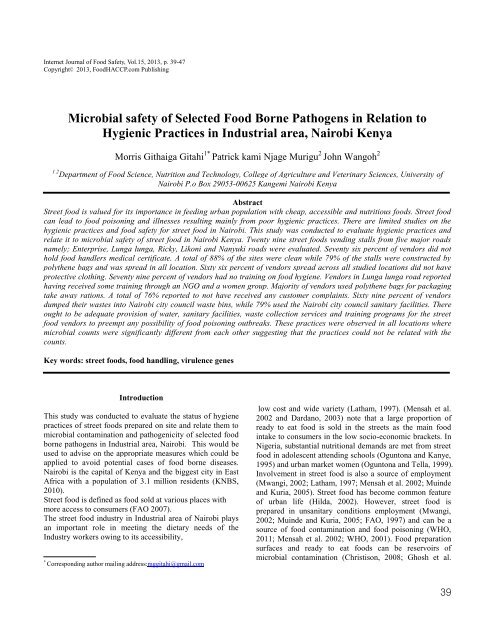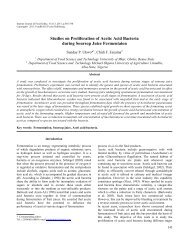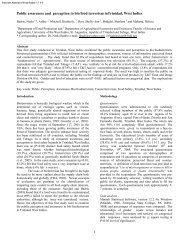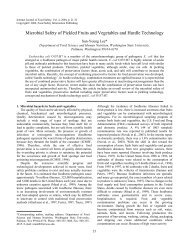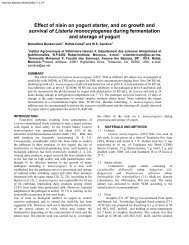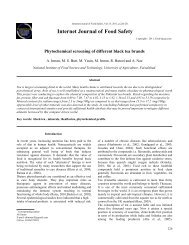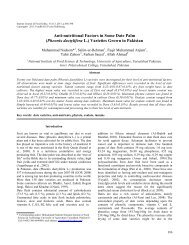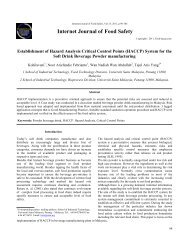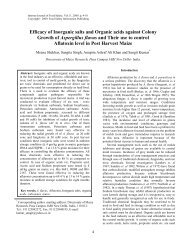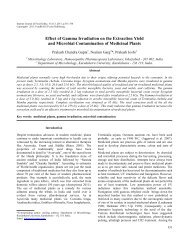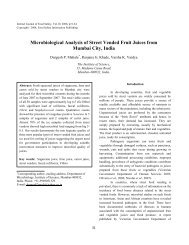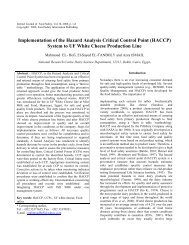Vol 15. 39-47 - Internet Journal of Food Safety = FoodHACCP.com
Vol 15. 39-47 - Internet Journal of Food Safety = FoodHACCP.com
Vol 15. 39-47 - Internet Journal of Food Safety = FoodHACCP.com
Create successful ePaper yourself
Turn your PDF publications into a flip-book with our unique Google optimized e-Paper software.
<strong>Internet</strong> <strong>Journal</strong> <strong>of</strong> <strong>Food</strong> <strong>Safety</strong>, <strong>Vol</strong>.15, 2013, p. <strong>39</strong>-<strong>47</strong><br />
Copyright© 2013, <strong>Food</strong>HACCP.<strong>com</strong> Publishing<br />
Microbial safety <strong>of</strong> Selected <strong>Food</strong> Borne Pathogens in Relation to<br />
Hygienic Practices in Industrial area, Nairobi Kenya<br />
Morris Githaiga Gitahi 1* Patrick kami Njage Murigu 2 John Wangoh 2<br />
1 2 Department <strong>of</strong> <strong>Food</strong> Science, Nutrition and Technology, College <strong>of</strong> Agriculture and Veterinary Sciences, University <strong>of</strong><br />
Nairobi P.o Box 29053-00625 Kangemi Nairobi Kenya<br />
Abstract<br />
Street food is valued for its importance in feeding urban population with cheap, accessible and nutritious foods. Street food<br />
can lead to food poisoning and illnesses resulting mainly from poor hygienic practices. There are limited studies on the<br />
hygienic practices and food safety for street food in Nairobi. This study was conducted to evaluate hygienic practices and<br />
relate it to microbial safety <strong>of</strong> street food in Nairobi Kenya. Twenty nine street foods vending stalls from five major roads<br />
namely; Enterprise, Lunga lunga, Ricky, Likoni and Nanyuki roads were evaluated. Seventy six percent <strong>of</strong> vendors did not<br />
hold food handlers medical certificate. A total <strong>of</strong> 88% <strong>of</strong> the sites were clean while 79% <strong>of</strong> the stalls were constructed by<br />
polythene bags and was spread in all location. Sixty six percent <strong>of</strong> vendors spread across all studied locations did not have<br />
protective clothing. Seventy nine percent <strong>of</strong> vendors had no training on food hygiene. Vendors in Lunga lunga road reported<br />
having received some training through an NGO and a women group. Majority <strong>of</strong> vendors used polythene bags for packaging<br />
take away rations. A total <strong>of</strong> 76% reported to not have received any customer <strong>com</strong>plaints. Sixty nine percent <strong>of</strong> vendors<br />
dumped their wastes into Nairobi city council waste bins, while 79% used the Nairobi city council sanitary facilities. There<br />
ought to be adequate provision <strong>of</strong> water, sanitary facilities, waste collection services and training programs for the street<br />
food vendors to preempt any possibility <strong>of</strong> food poisoning outbreaks. These practices were observed in all locations where<br />
microbial counts were significantly different from each other suggesting that the practices could not be related with the<br />
counts.<br />
Key words: street foods, food handling, virulence genes<br />
Introduction<br />
This study was conducted to evaluate the status <strong>of</strong> hygiene<br />
practices <strong>of</strong> street foods prepared on site and relate them to<br />
microbial contamination and pathogenicity <strong>of</strong> selected food<br />
borne pathogens in Industrial area, Nairobi. This would be<br />
used to advise on the appropriate measures which could be<br />
applied to avoid potential cases <strong>of</strong> food borne diseases.<br />
Nairobi is the capital <strong>of</strong> Kenya and the biggest city in East<br />
Africa with a population <strong>of</strong> 3.1 million residents (KNBS,<br />
2010).<br />
Street food is defined as food sold at various places with<br />
more access to consumers (FAO 2007).<br />
The street food industry in Industrial area <strong>of</strong> Nairobi plays<br />
an important role in meeting the dietary needs <strong>of</strong> the<br />
Industry workers owing to its accessibility,<br />
*<br />
Corresponding author mailing address:mggitahi@gmail.<strong>com</strong><br />
low cost and wide variety (Latham, 1997). (Mensah et al.<br />
2002 and Dardano, 2003) note that a large proportion <strong>of</strong><br />
ready to eat food is sold in the streets as the main food<br />
intake to consumers in the low socio-economic brackets. In<br />
Nigeria, substantial nutritional demands are met from street<br />
food in adolescent attending schools (Oguntona and Kanye,<br />
1995) and urban market women (Oguntona and Tella, 1999).<br />
Involvement in street food is also a source <strong>of</strong> employment<br />
(Mwangi, 2002; Latham, 1997; Mensah et al. 2002; Muinde<br />
and Kuria, 2005). Street food has be<strong>com</strong>e <strong>com</strong>mon feature<br />
<strong>of</strong> urban life (Hilda, 2002). However, street food is<br />
prepared in unsanitary conditions employment (Mwangi,<br />
2002; Muinde and Kuria, 2005; FAO, 1997) and can be a<br />
source <strong>of</strong> food contamination and food poisoning (WHO,<br />
2011; Mensah et al. 2002; WHO, 2001). <strong>Food</strong> preparation<br />
surfaces and ready to eat foods can be reservoirs <strong>of</strong><br />
microbial contamination (Christison, 2008; Ghosh et al.<br />
<strong>39</strong>
2007: Mankee et al. 2005). It has been established that<br />
ineffective personal hygiene can facilitate the transmission<br />
<strong>of</strong> pathogenic bacteria found in environment and on<br />
people’s hands via food to humans (Tambekar et al. 2008;<br />
Mensah et al. 2002). Street food vendors are <strong>of</strong>ten<br />
unlicensed, untrained in food safety, hygiene and sanitation,<br />
and work under unsanitary conditions (FAO, 1997).<br />
Materials and Methods<br />
A descriptive survey was conducted in Industrial area,<br />
Nairobi through structured questionnaires and observation<br />
as described by (Gay, 1982). Twenty nine sites were<br />
purposively selected to include vendors who prepare and<br />
sell food on site and formed the study area. The study sites<br />
involved included; 13 stalls from Enterprise road, 5 from<br />
Lunga lunga road, 6 from Ricky road , 3 from Likoni road<br />
and 2 from Nanyuki road. It covered areas on the stalls<br />
status, raw materials, food preparation work methodology,<br />
food handlers, utensils, sanitary facilities, customer<br />
<strong>com</strong>plaints and pests. Qualitative data descriptive analysis<br />
from the hygiene questionnaire among the locations was<br />
carried out with SPSS version 17.<br />
Fifty six samples from 7 food categories (FAO, 2011) were<br />
sampled from the selected stalls and analysed in a cross<br />
sectional study carried out between March and August year<br />
2011. All food sampled were prepared, vended and<br />
consumed on site. The foods sampled were served within<br />
three hours <strong>of</strong> preparation.<br />
Referenced results are extracted from a study conducted<br />
concurrently. Microbial counts and molecular typing were<br />
carried out using standard microbiological methods as<br />
reported in (Gitahi et al. 2012)<br />
Results<br />
Hygienic and sanitary status <strong>of</strong> food stalls and its<br />
environs Potential contaminants sources were evaluated in<br />
the study sites. The surrounding environment <strong>of</strong> the food<br />
vending facilities was assessed by observation for cobwebs,<br />
soot and dust.<br />
All locations were exposed to at least one potential source<br />
<strong>of</strong> contaminants. Waste water drainage tunnels were 24 %,<br />
(7/29) in the proximity stalls to roads. Vehicles passed<br />
within ten metres in 27 %, (8/29) <strong>of</strong> the street food vending<br />
stalls. Six percent (2/29) <strong>of</strong> the sites were considered safe<br />
from contaminants (Table 1) at the time <strong>of</strong> assessment.<br />
Other potential sources <strong>of</strong> contaminants included dusty<br />
within five metres, and mud and sludge within two metres.<br />
High frequency <strong>of</strong> stalls (85 %) in Enterprise road had food<br />
preparation and serving areas with drainage tunnels and<br />
passing vehicles as potential contaminants. The potential<br />
contaminants included houseflies with the highest<br />
occurrence at 55 % (16/29) <strong>of</strong> all stalls and 77 % (10/13) <strong>of</strong><br />
stalls in Enterprise road and soot in 21 %, 6/29 <strong>of</strong> all stalls.<br />
Dust and cobwebs were among the least <strong>com</strong>mon sources <strong>of</strong><br />
contaminants besides raw material peelings in one stall <strong>of</strong><br />
Lunga lunga road (Table 1).<br />
Table 1. Potential contaminants sources in five roads in<br />
Industrial area, Nairobi<br />
Enterprise<br />
n=13<br />
Ricky<br />
n=6<br />
Lunga<br />
lunga<br />
n=5<br />
Likoni<br />
n=3<br />
Nanyuki<br />
n=2<br />
Dusty road<br />
within two metres 7 % 0 % 0 % 0 % 0 %<br />
Drainage tunnel<br />
within five metres 11 % 0 % 30 % 33 % 0 %<br />
Dust 7 % 7 % 10 % 33 % 0 %<br />
Dusty road within<br />
five metres 3 % 0 % 0 % 0 % 0 %<br />
Garbage site<br />
within fifteen<br />
meters 3 % 7 % 0 % 0 % 0 %<br />
Mud and sludge<br />
within two meters 3 % 0 % 10 % 0 % 0 %<br />
Vehicles passing<br />
within ten meters 11 % 17 % 0 % 33 % 50 %<br />
None 3 % 9 % 0 % 0 % 0 %<br />
House fries 33 % 14 % 30 % 0 % 25 %<br />
Dust 0 % 7 % 0 % 0 % 0 %<br />
Soot 7 % 21 % 0 % 0 % 25 %<br />
Cobwebs 3 % 7 % 0 % 0 % 0 %<br />
Open air no risk 7 % 7 % 10 % 3 % 0 %<br />
Raw material<br />
peelings 0 % 0 % 10 % 0 % 0 %<br />
Cleanliness <strong>of</strong> vending stalls Majority <strong>of</strong> sampled stalls<br />
were found to be clean. Highest levels <strong>of</strong> cleanliness were<br />
observed in Enterprise road, (85 %) 11/13. Likoni road had<br />
100 % dirty stalls with dust, soot, cobwebs, houseflies and<br />
mud recorded at the time <strong>of</strong> assessment. Also, majority<br />
consisting <strong>of</strong> 83 % (24/29) <strong>of</strong> the stalls sampled were found<br />
to have clean equipment/utensils and vendors used soap in<br />
cleaning.<br />
Construction materials for the street food stalls An<br />
array <strong>of</strong> materials were used to construct the make shift<br />
stalls. Majority <strong>of</strong> stalls in all locations were constructed<br />
using polythene bags, while hard board and iron sheet were<br />
less <strong>com</strong>monly used (Table 2). One vendor operated in<br />
open air in Likoni road.<br />
Table 2. Construction materials used in the street food<br />
stalls from five selected locations in Industrial area,<br />
Nairobi<br />
Lunga<br />
Enterprise Ricky<br />
Likoni Nanyuki<br />
lunga<br />
n=13 n=6<br />
n=3 n=2<br />
n=5<br />
Polythene<br />
bags<br />
temporary<br />
42 % 40 % 40 % 50 % 100 %<br />
ro<strong>of</strong><br />
Polythene<br />
ro<strong>of</strong> and<br />
wall<br />
33 % 60 % 40 % 0 % 0 %<br />
40
percentage<br />
percentage<br />
Hardboard<br />
wall and<br />
polythene<br />
ro<strong>of</strong><br />
Iron sheet<br />
ro<strong>of</strong> and<br />
polythene<br />
wall<br />
Iron sheet<br />
ro<strong>of</strong> and<br />
wall<br />
Open air no<br />
ro<strong>of</strong> or wall<br />
8 % 0 % 0 % 0 % 0 %<br />
8 % 0 % 0 % 0 % 0 %<br />
8 % 0 % 20 % 0 % 0 %<br />
0 % 0 % 0 % 50 % 0 %<br />
<strong>Food</strong> handlers/vendors practices Possession <strong>of</strong> medical<br />
health certification by food handlers: Seventy six percent,<br />
(22/29) <strong>of</strong> vendors did not have a food handlers’ medical<br />
certificate in all the locations. Majority <strong>of</strong> those without<br />
certificates consisted <strong>of</strong> 92 %, (12/13) <strong>of</strong> vendors from<br />
Enterprise road (Figure 1).<br />
120%<br />
100%<br />
80%<br />
60%<br />
40%<br />
20%<br />
0%<br />
92%<br />
8%<br />
Enterprise<br />
road n=13<br />
No certificate<br />
50% 50%<br />
Ricky road<br />
n=6<br />
60%<br />
Has certificate<br />
40%<br />
Lunga lunga<br />
road n=5<br />
100%<br />
0%<br />
Likoni road<br />
n=3<br />
50% 50%<br />
Nanyuki road<br />
n=2<br />
Figure 1. The percentage <strong>of</strong> street food vendors with<br />
food handlers’ medical certification in five roads <strong>of</strong><br />
Industrial area, Nairobi<br />
Hand washing Majority (66 %) 19/29 <strong>of</strong> vendors from the<br />
sampled stalls did not facilitate washing hands <strong>of</strong> by<br />
customers. Among those who washed the customers’ hands,<br />
24 % (7/29) used a jug and a basin in hand washing while<br />
10 % (3/29) had a hand wash station with water and soap.<br />
No hand washing was done in Nanyuki road (Figure 2).<br />
Vendors in all the locations reported that most <strong>of</strong> the<br />
customers preferred partial packaging <strong>of</strong> the foods with<br />
polythene bags or use <strong>of</strong> cutlery altogether. Also, Use<br />
polythene bags to package take away rations was spread in<br />
all locations, while use <strong>of</strong> personal containers and maize<br />
leaves was used in one stall.<br />
Hand washing station with soap and water Uses jug and basin No hand washing<br />
120%<br />
100%<br />
80%<br />
60%<br />
40%<br />
20%<br />
0%<br />
15% 15%<br />
69%<br />
0%<br />
50% 50%<br />
Enterprise road Ricky road n=6<br />
n=13<br />
20% 20%<br />
60%<br />
Lunga lunga<br />
road n=5<br />
33%<br />
67%<br />
0% 0% 0%<br />
Likoni road<br />
n=3<br />
100%<br />
Nanyuki road<br />
n=2<br />
Figure 2: The percentage <strong>of</strong> hand washing by customers<br />
in street food stalls <strong>of</strong> Industrial area, Nairobi from five<br />
locations<br />
Protective clothing Thirty four percent (10/29) <strong>of</strong> the<br />
vendors used protective garment. However, only 10 %<br />
(3/29) had <strong>com</strong>plete coats while 24 % (7/29) had half coats<br />
which could not <strong>of</strong>fer protection. The lack <strong>of</strong> protective<br />
coat was noted in all the locations but high levels in<br />
Enterprise 85 % (11/13) and all 3 (100 %) stalls in Likoni<br />
roads (Figure 3).<br />
120%<br />
100%<br />
80%<br />
60%<br />
40%<br />
20%<br />
0%<br />
15%<br />
Has protectine clothing<br />
85%<br />
50% 50%<br />
Enterprise road Ricky road n=6<br />
n=13<br />
80%<br />
No protective clothing<br />
20%<br />
Lunga lunga<br />
road n=5<br />
0%<br />
100%<br />
Likoni road<br />
n=3<br />
50% 50%<br />
Nanyuki road<br />
n=2<br />
Figure 3. The percentage <strong>of</strong> vendors wearing protective<br />
coats in the street food stalls <strong>of</strong> five roads in Industrial<br />
area, Nairobi<br />
Twenty four percent (7/29) <strong>of</strong> the vendors who had<br />
protective clothing washed their coats on a weekly basis,<br />
while 69 % washed the coats when visually dirty and 100 %<br />
in Enterprise road.<br />
41
Training <strong>of</strong> street food vendors on food hygiene and<br />
safety Only 6/29 (21 %) have had training on food<br />
hygiene and food safety (Table 3). Another 7 % (2/29)<br />
relied on basic primary education, 2 vendors in Enterprise<br />
road had secondary school training while 2 vendors in<br />
Lunga lunga road had training from NGO and women<br />
groups.<br />
Table 3: <strong>Food</strong> hygiene training amongst street food<br />
vendors in five selected roads in Industrial area, Nairob<br />
Lunga<br />
Ricky<br />
Likoni Nanyuki<br />
Enterprise<br />
lunga<br />
road<br />
road road<br />
road n=13<br />
road<br />
n=6<br />
n=3 n=2<br />
n=5<br />
No<br />
training<br />
77 % 100 % 40 % 100 % 100 %<br />
Basic<br />
education 7 % 0 % 20 % 0 % 0 %<br />
in primary<br />
Basin<br />
education<br />
in<br />
15 % 0 % 0 % 0 % 0 %<br />
secondary<br />
NGO and<br />
women 0 % 0 % 40 % 0 % 0 %<br />
groups<br />
<strong>Food</strong> handling practices before serving Holding food<br />
after cooking and before serving: Majority consisting <strong>of</strong><br />
82 %, (23/28) <strong>of</strong> respondents let the food cool naturally<br />
while they wait for the customers. All vendors in Lunga<br />
lunga and Nanyuki road reported to let the food cool<br />
naturally. Others 8 % in Enterprise road and 17 % in Ricky<br />
road held their food on hot surface while some held the<br />
food warm (Table 4).<br />
Table 4. Method <strong>of</strong> food holding after cooking and prior<br />
to serving by street food vendors in five elected roads<br />
from Industrial area, Nairobi<br />
Left to<br />
cool<br />
naturally<br />
Held on<br />
hot<br />
surface<br />
Held<br />
Enterprise<br />
road n=13<br />
Ricky<br />
road<br />
n=6<br />
Lunga<br />
lunga<br />
road<br />
n=5<br />
Likoni<br />
road<br />
n=3<br />
Nanyuki<br />
road<br />
n=2<br />
92 % 50 % 100 % 67 % 100 %<br />
8 % 17 % 0 % 0 % 0 %<br />
0 % 33 % 0 % 33 % 0 %<br />
warm<br />
Water quality and handling <strong>of</strong> raw materials All the<br />
vendors do not treat or boil their drinking water. Majority<br />
62 % (18/29) <strong>of</strong> vendors obtain their water from street<br />
water vendors and water kiosks 34 % (10/29) while a<br />
vendor in Enterprise road carries water from home. Some<br />
vendors in Enterprise road obtain water from both water<br />
kiosks and water vendors while all vendors in Likoni and<br />
Nanyuki roads obtain from water vendors (Table 5).<br />
Table 51. Sources <strong>of</strong> water for street food vendors from<br />
locations in Industrial area, Nairobi<br />
Lunga<br />
Likoni Nanyuki<br />
Enterprise Ricky lunga<br />
road road<br />
road n=13 road n=6 road<br />
n=3 n=2<br />
n=5<br />
Water<br />
kiosk<br />
54 % 40 % 20 % 0 0<br />
Water<br />
vendors<br />
54 % 60 % 80 % 100 % 100 %<br />
Home 1 0 0 0 0<br />
Majority 52 % (15/29) <strong>of</strong> the vendors obtained their raw<br />
materials from local groceries, followed by Wakulima<br />
market 38 % (11/29), local shops 31 % (9/29), local<br />
butcheries, Kia Michael market and raw food<br />
vendors/suppliers. Local sourcing was widely practiced<br />
(Table 6). Most vendors had multiple sources <strong>of</strong> food raw<br />
materials.<br />
Table 6. Sources <strong>of</strong> raw material for the street food<br />
vendors in five locations in Industrial area, Nairobi<br />
Enterprise<br />
road n=13<br />
Ricky<br />
road<br />
n=6<br />
Lunga<br />
lunga<br />
road n=5<br />
Likoni<br />
road<br />
n=3<br />
Nanyuki<br />
road<br />
n=2<br />
Wakulima 18 % 30 % 43 % 33 % 0 %<br />
Raw food<br />
vendors 5 % 0 % 0 % 0 % 0 %<br />
Local groceries<br />
grain vegetables<br />
vendors 36 % 20 % 43 % 33 % 25 %<br />
Local<br />
butcheries 9 % 10 % 0 % 0 % 50 %<br />
Kia Michael 9 % 20 % 0 % 0 % 0 %<br />
Local shops 18 % 20 % 14 % 33 % 25 %<br />
Some food<br />
precooked at<br />
home 5 % 0 % 0 % 0 % 0 %<br />
Pests None <strong>of</strong> the respondents reported having encountered<br />
any pest or rodent. No control measure was noted to have<br />
been used because they encountered none.<br />
Customer <strong>com</strong>plaints Only 21 % (6/29) <strong>of</strong> vendors had<br />
received customer <strong>com</strong>plaints (Table 7) including; food<br />
quality consistency, flavour, taste and texture in Enterprise<br />
road, Ricky and Nanyuki roads and poor ration mixture in<br />
Lunga lunga.<br />
Table 7. Customer <strong>com</strong>plains in street food stalls from<br />
five locations in Industrial area, Nairobi<br />
Enterprise<br />
road n=13<br />
Ricky<br />
road<br />
n=6<br />
Lunga<br />
lunga<br />
road<br />
n=5<br />
Likoni<br />
road<br />
n=3<br />
Nanyuki<br />
road<br />
n=2<br />
<strong>Food</strong><br />
quality<br />
consistency<br />
flavour<br />
taste and<br />
texture 31 % 17 % 0 % 0 % 50 %<br />
Ration<br />
mixing 0 % 0 % 20 % 0 % 0 %<br />
42
frequency<br />
None 69 % 83 % 80 % 100 % 50 %<br />
Waste disposal Seventy two percent (21/29) <strong>of</strong> vendors<br />
dump wastes from their stalls into Nairobi city council<br />
waste bins. Only 31 % (9/29) sell the vegetable wastes. A<br />
vendor in Likoni road drains the waste water into the<br />
drainage nearby (Table 8).<br />
Table 8. Methods <strong>of</strong> waste disposal by the vendors <strong>of</strong><br />
street foods from five locations in Industrial area,<br />
Nairobi<br />
Enterprise<br />
road n=13<br />
Ricky<br />
road<br />
n=6<br />
Lunga<br />
lunga<br />
road<br />
n=5<br />
Likoni<br />
road<br />
n=3<br />
Nanyuki<br />
road<br />
n=2<br />
NCC bins 85 % 67 % 60 % 33 % 100 %<br />
Sell vegetable<br />
wastes 50 % 80 % 33 % 0 %<br />
Wash water to drain 0 % 0 % 0 33 % 0 %<br />
Access to sanitary facilities Seventy nine percent, (23/29)<br />
vendors use the Nairobi City Council (NCC) sanitary<br />
facilities (toilets) while 21 % (6/29) use sanitary facilities in<br />
the nearby slums (Figure 4). All vendors in Lunga lunga,<br />
Likoni and Nanyuki roads used NCC toilets.<br />
120%<br />
100%<br />
80%<br />
60%<br />
40%<br />
20%<br />
0%<br />
NCC facilities<br />
85%<br />
15%<br />
Enterprise<br />
road n=13<br />
33%<br />
67%<br />
Ricky road<br />
n=6<br />
Residential areas in the near by slum<br />
100% 100% 100%<br />
Lunga lunga<br />
road n=5<br />
0% 0% 0%<br />
Likoni road<br />
n=3<br />
Nanyuki road<br />
n=2<br />
Figure 4. Sanitary facilities used by street food vendors<br />
in five locations in Industrial area, Nairobi<br />
Discussion<br />
Studies have indicated that ready to eat foods and food<br />
preparation surfaces may be reservoirs for microbial<br />
contamination (Mankee et al. 2005; Ghosh et al. 2007;<br />
Christison et al. 2008). Street foods can also be sources <strong>of</strong><br />
enteropathogens (Mensah et al. 2002). <strong>Food</strong> borne<br />
microorganisms cause disease through infection or<br />
intoxication.<br />
Majority <strong>of</strong> street food vending stalls (22/29) were clean at<br />
the time <strong>of</strong> the survey signifying an effort by the vendors to<br />
keep their area <strong>of</strong> work clean. This was despite some stalls<br />
being exposed to potential contaminants and houseflies in<br />
all the locations except Likoni road stalls. The presence <strong>of</strong><br />
houseflies implies probable lack <strong>of</strong> adequate sanitation.<br />
This agreed with (Muinde and Kuria (2005) who found<br />
houseflies in most <strong>of</strong> the street food stalls in Nairobi.<br />
Muganga, 2001 noted house flies in 54.8 % <strong>of</strong> the vending<br />
stalls. This implies that food contamination is most likely to<br />
occur despite efforts to keep the stalls clean. In a study<br />
conducted in Ghana by Annan-Prah et al (2011), food items<br />
were sold in the open-air which was dusty, near drainage<br />
gutters and some near garbage bins. Muinde and Kuria,<br />
(2005) reported about 85 % <strong>of</strong> the vendors prepared their<br />
foods in unhygienic conditions given that garbage and dirty<br />
waste were close to the vending stalls. In some <strong>of</strong> the stalls<br />
vehicles passed by within ten meters while 97.6 % stalls<br />
were situated where vehicles passed within 20 meters radius.<br />
The maintenance <strong>of</strong> clean stalls is made difficult by the<br />
nature <strong>of</strong> construction material given the fact that most<br />
stalls where constructed using polythene bags. This was<br />
also observed in a study carried out by Muinde and Kuria<br />
(2005) where most <strong>of</strong> the stalls in Nairobi (23/29) were<br />
made <strong>of</strong> polythene bags and wood, which are difficult to<br />
clean and sanitize. In the present study equipment was clean<br />
and that majority <strong>of</strong> the vendors cleaned the utensils after<br />
every meal using soap during cleaning. These practices<br />
were observed in all locations where microbial counts were<br />
significantly different from each other suggesting that the<br />
practices could not be related with the counts.<br />
In terms <strong>of</strong> medical certificates, only 24 % (7/29) vendors<br />
had food handlers’ medical certificate. This was lower than<br />
levels noted in the streets <strong>of</strong> Accra Ghana (40 %) by Ackah<br />
et al. (2011). Annan-prah et al. (2011) observed that 45 %<br />
<strong>of</strong> street food vendors in Cape coast Ghana were not<br />
certified medically to handle food. As highlighted in the<br />
standard newspaper, Kenya <strong>of</strong> September 13 2011, there is<br />
a need to ensure food handlers are immunized or treated<br />
against typhoid and other food borne illnesses. There is a<br />
gap to ensure only medically fit food vendors handle ready<br />
to eat foods. The highest percentage <strong>of</strong> vendors without<br />
food handlers medical certificate were in Enterprise road<br />
where microbial counts were lower that other locations with<br />
relative higher vendor with the certificates (Gitahi et al.<br />
2012) suggesting this could not be determinant in microbial<br />
counts <strong>of</strong> the street food.<br />
The equipment could be contaminated during the drying<br />
step where the vendors overturned the utensils on a basin<br />
and on a make shift rack uncovered and could not protect<br />
the utensils from possible contamination from the<br />
environment.<br />
Only 34 %, 10/29 <strong>of</strong> the vendors provide equipment for<br />
hand washing. Some use a jug and a basin to aid in hand<br />
43
washing, while others had a hand wash station with water<br />
and soap. This differs from a study by Muganga (2001)<br />
where it was revealed that 50 % <strong>of</strong> vendors had hand<br />
washing vessels. It has been established that ineffective<br />
personal hygiene can facilitate the transmission <strong>of</strong> these<br />
pathogenic bacteria found in environment and on people’s<br />
hands through food to humans (Tambekar et al. 2008;<br />
Mensah et al. 2002). Atbara city, Nahr Elneel, Sudan where<br />
98% <strong>of</strong> the respondents agreed the hand must be washed<br />
before eating meal (Abdalla et al. 2009). Consumers were<br />
reported to prefer using cutlery instead <strong>of</strong> finger food eating.<br />
This could eliminate contamination during eating since<br />
there is no contact between unwashed hands and the food.<br />
This disparity in hand washing practices indicated no<br />
relationship to microbial counts reported by Gitahi et<br />
al.2012.<br />
Sixty six percent (66 %), (19/29) <strong>of</strong> the vendors did not<br />
have protective clothing and could not protect the foods<br />
they handle from any contamination from their bodies and<br />
clothing. The wearing <strong>of</strong> protective coats by personnel was<br />
50 % in Ricky road and 15 % in Enterprise road. Majority<br />
<strong>of</strong> the food vendors in Enterprise road, 92 % did not have<br />
protective coats while prominent contaminants were dust,<br />
houseflies, and vehicles passing by.<br />
Muinde and Kuria (2005) also reported that 81.3 % <strong>of</strong> the<br />
vendors did not use aprons.<br />
There was a lack <strong>of</strong> training; 79 % (23/29 <strong>of</strong> the vendors<br />
were not trained suggesting lack <strong>of</strong> control in food<br />
protection from contaminants. This was also as noted in<br />
India by Tambekar et al (2011) where food vendors were<br />
unaware <strong>of</strong> food regulations and were untrained on food<br />
hygiene. Despite the variation in the use <strong>of</strong> personal<br />
protective clothing and lack <strong>of</strong> food safety and hygiene<br />
training, the microbial counts in the study locations were<br />
not significantly different suggesting microbial counts were<br />
not determined by these two parameters.<br />
Majority <strong>of</strong> the vendors 79 % (23/29) left the food cool<br />
naturally which could lead to multiplication <strong>of</strong><br />
microorganisms present in the food at the time <strong>of</strong> storage.<br />
However, this food was always served within 3 hours <strong>of</strong><br />
cooking and mostly when hot. Two food categories:<br />
vegetables and meat (fish) had unacceptable levels <strong>of</strong><br />
Staphylococcus aureus possibly emanating from post<br />
cooking handling in fish while the vegetables were<br />
primarily salads (uncooked). Eighty seven per cent (26/29)<br />
<strong>of</strong> the vendors use polythene bags to wrap take away rations.<br />
Muganga (2001) in contrast reported that printed papers<br />
were the major packaging media in street foods in Nairobi.<br />
This could have resulted from the revolution into use <strong>of</strong><br />
plastics recently to replace most other packaging material.<br />
Annan-prah et al. (2011) also had observed that 6 % <strong>of</strong><br />
street food vendors in Cape coast Ghana use newsprints,<br />
and 20 % polythene bags to package food. The increase in<br />
the usage <strong>of</strong> polythene bags in Nairobi suggest measures are<br />
required to ensure these packaging forms are free <strong>of</strong> any<br />
potential food contaminant.<br />
All vendors have not received any customer <strong>com</strong>plaints<br />
related to food safety while some 21 % (6/29) stated to have<br />
received <strong>com</strong>plaints on the texture and consistency <strong>of</strong> the<br />
foods. Three per cent <strong>of</strong> vendors have received <strong>com</strong>plains<br />
on the varying quantities <strong>of</strong> the rations/menus. Annan-prah<br />
et al. (2011) observed that only 4 % <strong>of</strong> street food clients in<br />
Cape coast Ghana were concerned with hygienic<br />
considerations <strong>of</strong> street food. This could be the case in<br />
Kenya where street food customers may have not reported<br />
food borne disease.<br />
Majority <strong>of</strong> the vendors obtained water from water vendors<br />
(62 %; 18/29) and water kiosks (34 %; 10/29) indicating<br />
dependence on water supply the vendors have no control<br />
over. This agreed to a study by Muganga in 2001 where<br />
majority <strong>of</strong> vendors obtained water from kiosks, suggesting<br />
more people engage in water vending business in the streets.<br />
Muinde and Kuria (2005) observed that water was ferried<br />
from homes <strong>of</strong> the street food vendors because no potable<br />
water was available at their areas <strong>of</strong> operation. However,<br />
this water may not be enough for dish washing and food<br />
preparation.<br />
Water in all the stalls is not boiled before serving for<br />
drinking suggesting the need for assurance that the water<br />
must be safe for human consumption from the source if the<br />
water is not obtained from treated sources <strong>of</strong> the city<br />
council. Some vendors (31 %) did not wash their raw food<br />
before cooking. These results agree with those <strong>of</strong> Muinde<br />
and Kuria (2005) who found that vendors did not wash<br />
fresh foods properly. Pathogens may enter the food system<br />
during preparation, cooking, packaging or marketing (Barro<br />
et al. 2007). Vendors obtained their raw materials from<br />
multiple sources indicating the need for a wider approach in<br />
addressing the safety <strong>of</strong> street food. There ought to be<br />
traceability measures in the pursuit to ensure safe street<br />
food in Nairobi city <strong>of</strong> Kenya.<br />
Majority (69 %) <strong>of</strong> vendors dump their waste into<br />
Nairobi City Council waste bins. Some vendors (21 %) sell<br />
the vegetable wastes while 33 % 0f vendors in Likoni road<br />
drain the waste water into the drainage nearby. These<br />
disposal methods do not pose a threat in contamination <strong>of</strong><br />
street food prepared and consumed on site. Muinde and<br />
Kuria (2005) reported that 92.5 % <strong>of</strong> street food vendors in<br />
which Nairobi did not have garbage receptacles; hence they<br />
disposed their garbage near the stalls. This suggests waste<br />
bins may have been introduced in which Nairobi city after<br />
the study by Muinde and Kuria (2005).<br />
A total <strong>of</strong> 79 % (23/29) vendors sampled use the NCC<br />
sanitary facilities while 21 % use the nearby slums which<br />
indicate the need to improve access <strong>of</strong> these facilities in the<br />
streets where the food vending business is prevalent. The<br />
NCC has created access for this. There however need to be<br />
awareness creation for people to use more <strong>of</strong> the existing<br />
facilities.<br />
44
Conclusion<br />
The findings <strong>of</strong> this study reveal areas <strong>of</strong> improvement<br />
which could be implemented towards attaining safe street<br />
food.<br />
Majority 76 % <strong>of</strong> vending stalls were seen to be clean<br />
which indicates an effort by the vendors to keep their<br />
premises clean. However, there is a need to ensure the stalls<br />
are properly located to prevent the food contamination from<br />
the potential contaminants. Construction materials should<br />
be designed for easier cleaning. Seventy six per cent <strong>of</strong><br />
vendors did not hold food handlers’ medical certificate. It is<br />
re<strong>com</strong>mended that medical screening be carried as a<br />
requirement as any carrier <strong>of</strong> a food pathogen can<br />
contaminate food.<br />
Only 34 % <strong>of</strong> the vendors hand washes their customers.<br />
Most customers were reported to prefer polythene bags and<br />
cutlery instead <strong>of</strong> washing hands. Stalls owners and the<br />
food handlers should be trained to embrace a hand washing<br />
culture to avoid any food contamination. This should<br />
augment already existing media advertisations to embrace<br />
hand washing. Emphasis should be moved from school<br />
children alone to the whole population.<br />
Only 34 % vendors wore protective clothing and majority<br />
could not protect the food from contamination emanating<br />
from their bodies. The wearing <strong>of</strong> protective clothing will<br />
need to be enforced to ensure potential <strong>of</strong> food<br />
contamination is reduced.<br />
There were no customer <strong>com</strong>plaints regarding food safety<br />
signifying a higher level <strong>of</strong> satisfaction by consumers on the<br />
services obtained from these stalls or ignorance altogether.<br />
It could also mean under reporting <strong>of</strong> the <strong>com</strong>plaints.<br />
Training on food hygiene and food safety was lacking in<br />
79 % <strong>of</strong> the vendors. All vendors were women and<br />
consideration can be enhanced by food hygiene training<br />
programs that can be correlated to women participation in<br />
the society.<br />
A total <strong>of</strong> 79 % vendors could let the food cool naturally<br />
and if the food is not purchased and served when hot, there<br />
is potential microbial multiplication if contamination occurs.<br />
A total <strong>of</strong> 90 % vendors use polythene bags to wrap/pack<br />
take away rations. The high frequency <strong>of</strong> usage <strong>of</strong><br />
polythene bags to package food will required these material<br />
evaluated for potential source <strong>of</strong> contamination.<br />
Seventy nine percent; (79 %), (23/29) <strong>of</strong> the vendors used<br />
NCC sanitary facilities. The high level <strong>of</strong> dependence <strong>of</strong><br />
NCC facilities indicates a need to harmonize and provide<br />
services at close proximity to the food vendors and their<br />
clients.<br />
The water is not boiled before serving to customers. Since<br />
some (7 %) <strong>of</strong> this water is not obtained from treated<br />
sources <strong>of</strong> the NCC, then it should be evaluated as a<br />
potential source <strong>of</strong> food contamination. The water can also<br />
be contaminated during vending and could be evaluated.<br />
The out<strong>com</strong>e <strong>of</strong> this study can serve as a baseline data for<br />
management and improvement <strong>of</strong> the street food safety<br />
based on these areas.<br />
From the referenced study (Gitahi at al., 2012), the<br />
vegetable foods the highest total viable counts at 4.71 ±0.3<br />
log 10 cfu/g, highest total coliforms counts at 4.48 log 10 cfu/g<br />
and highest Staphylococcus aureus at 4.03 log 10 cfu/g. All<br />
vegetables were served raw. They were not heat treated and<br />
were held at ambient temperature between preparation and<br />
service.<br />
Vegetables from Ricky road were sourced from Wakulima<br />
market and local groceries and had the highest<br />
Staphylococcus aureus counts <strong>of</strong> 4.69±0.05 log 10 cfu/g.<br />
There was significantly similar (p
coliforms <strong>of</strong> 4.10 log 10 cfu/g; levels above the limits <strong>of</strong> 4.00<br />
log 10 cfu/g (KEBS, 2003). It was noted in Nanyuki road that<br />
50 % vendors had no food handlers’ medical certificate and<br />
protective coat and additionally no food hygiene training<br />
and no hand washing <strong>of</strong> clients.<br />
The presence <strong>of</strong> unacceptable levels <strong>of</strong> coliforms in meat<br />
(fish) from Nanyuki road may suggest inadequate handling<br />
during the display <strong>of</strong> fish before sale by the vendors. In this<br />
location 50 % <strong>of</strong> stalls were dusty and had houseflies<br />
suggesting inadequate sanitation.<br />
In the legume based street foods, Enterococci species<br />
counts were lowest in legumes (2.04 ±0.06 log 10 cfu/g).<br />
Coliform counts were 2.33 log 10 cfu/g and 3.37 log 10 cfu/g<br />
for Staphylococcus aureus. All legumes met microbial<br />
safety standards (KEBS, 2003; Gilbert et al. 2000).<br />
Microbial counts in starchy roots based street foods were<br />
2.42 log 10 cfu/g for coliform and 2.44 log 10 cfu/g for<br />
Enterococci. No microorganisms were detected in starchy<br />
roots from Ricky and Lunga lunga. The absence was<br />
expected from the fact that these foods are extensively<br />
boiled on site and peeled before serving.<br />
Microbial counts in cereal were within the standards or<br />
limits for acceptable street foods (KEBS, 2003; Gilbert et al.<br />
2000).<br />
In the mixed dishes, Escherichia coli were qualitatively<br />
detected from only one sample. These foods are extensively<br />
boiled. This may be why microbial count was low at 2.70-<br />
2.90 log 10 cfu/g for coliforms and 3.30 - 3.34 log 10 cfu/g for<br />
Staphylococcus aureus.<br />
The beverage had the lowest total viable counts at 3.19 ±<br />
0.2 log 10 cfu/g. Coliforms, Staphylococcus aureus and<br />
Enterococci species were not detected in the beverage foods.<br />
This was expected since these foods were heated to boiling<br />
during cooking and were subsequently served hot.<br />
Strains <strong>of</strong> Escherichia coli detected in vegetables from<br />
Lunga lunga and Likoni road and mixed dish (githeri from<br />
Likoni road) were confirmed to be different through Rep<br />
PCR analysis against reference strains previously reported<br />
to contain virulence genes stx2, stx1 and eae by Kohler et al.<br />
(2008).<br />
Staphylococcus aureus isolated from street food do not<br />
possess enterotoxigenic genes that code for production <strong>of</strong><br />
(se) staphylococcal enterotoxin genes d and g (Gitahi et al.<br />
2012)<br />
Studies are also required to establish the safety <strong>of</strong> water<br />
used in the street food preparation and the efficacy <strong>of</strong> the<br />
hygienic practices in the street food stalls <strong>of</strong> Nairobi, Kenya.<br />
References<br />
Abdalla M. A. S. E. Suliman and A. O. Bakhiet. 2009. <strong>Food</strong><br />
safety knowledge and practices <strong>of</strong> street food vendors<br />
in Atbara City (Naher Elneel State Sudan) African<br />
<strong>Journal</strong> <strong>of</strong> Biotechnology <strong>Vol</strong>. 8 (24): 6967-6971<br />
Ackah M. E.T. Gyamfi1, A.K. Anim1, J. Osei, J.K. Hansen<br />
O. Agyemang. 2011. Socio-Economic Pr<strong>of</strong>ile,<br />
Knowledge <strong>of</strong> Hygiene and <strong>Food</strong> <strong>Safety</strong> Practices<br />
among Street-<strong>Food</strong> Vendors in some parts <strong>of</strong> Accra-<br />
Ghana. <strong>Internet</strong> <strong>Journal</strong> <strong>of</strong> <strong>Food</strong> <strong>Safety</strong> <strong>Vol</strong>.13: 191-<br />
197<br />
Annan-Prah A. D. H. A. K. Amewowor, J. Osei-K<strong>of</strong>i, S. E.<br />
Amoono, S. Y. Akorli, E. Saka and H. A. Ndadi. 2011.<br />
Street foods: Handling, hygiene and client<br />
expectations in a World Heritage Site Town, Cape<br />
Coast, Ghana. African <strong>Journal</strong> <strong>of</strong> Microbiology<br />
Research <strong>Vol</strong> 5(13): 1629-1634<br />
Barro N. A. R. Bellow, Y. Savagodo and C.A.T. Ouattara.<br />
2007. Street vended food improvement:<br />
Contamination mechanisms and application <strong>of</strong> food<br />
safety objective strategy: Critical review. Pak J Nutr<br />
<strong>Vol</strong> 6:1-10<br />
Christison C.A., Lindsay D. and von Holy A. 2008.<br />
Microbiological survey <strong>of</strong> ready-to-eat foods and<br />
associated preparation surfaces in retail delicatessens,<br />
Johannesburg, South Africa. <strong>Food</strong> Control <strong>Vol</strong><br />
19:727–733<br />
Dardano C. 2003. Carribean regional working group on<br />
street food vendors. Report <strong>of</strong> FAO, PAHO and BNSI.<br />
ftp:ftp.fao.org/es/esn/food/c arribean_report.pdf<br />
FAO <strong>Food</strong> consumption food group accessed on 15 th<br />
January 2011<br />
http://www.fao.org/fileadmin/templates/ess/document<br />
s/food_security_statistics/<strong>Food</strong>Consumption<strong>Food</strong>Grou<br />
ps_en.xls<br />
FAO. 1997. Agriculture food and nutrition for Africa: A<br />
resource book for teachers <strong>of</strong> Agriculture. FAN<br />
Rome 1997, 123<br />
FAO. 2007. The informal food sector"<br />
http://www.informalfood.unibo.it 2007-11-23.<br />
Gay LR 1982. Educational Research Competencies for<br />
analysis and application. Merrill publishing <strong>com</strong>pany,<br />
Toronto: 246.<br />
Ghosh M. Wahi S. Kumar M. and Ganguli, 2007.<br />
Prevalence <strong>of</strong> enterotoxigenic Staphylococcus aureus<br />
and Shigella species in some raw street vended Indian<br />
foods. Int J Environ Health Res 2007 <strong>Vol</strong> 17:151–156.<br />
Gilbert R. J. J., T. Donovan, C. Little, K. Nye, C.D. Ribeiro,<br />
J. Richards, D. Roberts and F.J. Bolton. 2000. PHLS<br />
advisory Committee for the <strong>Food</strong> and Dairy Products.<br />
Guidelines for the microbiological quality <strong>of</strong> some<br />
selected ready to eat foods sampled at the point <strong>of</strong> sale.<br />
Commun Dis Public Health <strong>Vol</strong> 3:163-7<br />
Gitahi M.G., J. Wangoh and P.M.K. Njage, 2012. Microbial<br />
<strong>Safety</strong> <strong>of</strong> Street <strong>Food</strong>s in Industrial Area,<br />
46
Nairobi. Research <strong>Journal</strong> <strong>of</strong> Microbiology, 7: 297-308.<br />
Hilda Van t Riet. 2002. The role <strong>of</strong> street foods in the diet<br />
<strong>of</strong> low-in<strong>com</strong>e urban residents, the case <strong>of</strong> Nairobi.<br />
PhD Thesis. Page: 86- 92<br />
Kenya Bureau <strong>of</strong> Standards. 2003. Standard<br />
microbiological limits <strong>of</strong> foods K. S. 05 – 220,<br />
Government Press Nairobi, Kenya. 1-7.<br />
Kenya National Bureau <strong>of</strong> Statistics. 2010. Accessed 15 th<br />
March 2011 http://www.knbs.or.ke<br />
Kohler R. G., Krause, L. Bentin, B. Stephan and C. Zweifel.<br />
2008. Shedding <strong>of</strong> food borne pathogens and<br />
microbiological carcass contamination in rabbits at<br />
slaughter. Vet microbial <strong>Vol</strong> 132: 149-157<br />
Latham M.C. 1997. Human nutrition in tropical Africa.<br />
FAO, Rome. 329-437.<br />
Mankee A., Ali S., and Chin A.L. 2005. Microbial quality<br />
<strong>of</strong> “doubles” sold in Trinidad. <strong>Food</strong> Microbiol <strong>Vol</strong><br />
22:601–607<br />
Mensah P, Manu DY, Darko KO, and Ablordey A. 2002.<br />
Streets foods in Accra, Ghana: how safe are they?<br />
Bulletin <strong>of</strong> World Health Organization. <strong>Vol</strong> 80(7):<br />
546-554.<br />
Muganga, M.E.N., 2001. Nutritional and safety quality <strong>of</strong><br />
street foods in Korogocho and industrial area <strong>of</strong><br />
Nairobi, Kenya. M.Sc. Thesis, University <strong>of</strong> Nairobi,<br />
Kenya.<br />
Muinde O.K. and Kuria E. 2005. Hygienic and sanitary<br />
practices <strong>of</strong> vendors <strong>of</strong> street foods in Nairobi, Kenya.<br />
AJFAND online www.ajfand.net <strong>Vol</strong> 5 (1): 1-1<br />
Mwangi A.M. 2002. Nutritional, hygienic and socioeconomic<br />
Dimensions <strong>of</strong> Street <strong>Food</strong>s in Urban Areas:<br />
The Case <strong>of</strong> Nairobi. Wageningen University.<br />
Dissertation No. 3157 (Abstract) March. Page: <strong>47</strong>- 79<br />
Ogontona C.R.B. and Kanye O. 1995. Contribution <strong>of</strong> street<br />
foods to nutrient intakes by Nigerian adolescents.<br />
Nutrition and Health <strong>Vol</strong> 10: 165-171<br />
Ogontona C.R.B. and Tella T. O. 1999. Street foods and<br />
dietary intakes <strong>of</strong> Nigeria urban market women.<br />
International <strong>Journal</strong> <strong>of</strong> <strong>Food</strong> Science and Nutrition<br />
<strong>Vol</strong> 50:383-<strong>39</strong>0<br />
Tambekar D. H. Kulkarni R. V. S. D. Shirsat and D. G.<br />
Bhadange. 2011. Bacteriological quality <strong>of</strong> street<br />
vended food Panipuri. A case study <strong>of</strong> Amravati city<br />
(ms) India. Bioscience discovery <strong>Vol</strong> 2 (3):350-354<br />
Tambekar D.H, Gulhane S.R., Jaisingkar R.S., Wangikar<br />
M.S., Banginwar Y.S., and Mogarekar M.R. 2008.<br />
Household Water management: A systematic study <strong>of</strong><br />
bacteriological contamination between source and<br />
point-<strong>of</strong>-use. American-Eurasian <strong>Journal</strong> <strong>of</strong><br />
Agricultural and Environmental Science. <strong>Vol</strong> 3(2):<br />
241-246.<br />
The standard newspaper Tuesday September 13 2011.<br />
Kenya. Available on<br />
http://medicalkenya.co.ke/2011/09/there%E2%80%99<br />
s-good-reason-to-vaccinate-food-handlers (Accessed<br />
on 30 th September 2011)<br />
WHO. 2001. World Health Organization. Background<br />
paper: Developing a food safety strategy. WHO<br />
Strategic Planning Meeting, Geneva. Page 1-16<br />
https://apages.who.int/fsf/Documents/BACKGROUN<br />
D%20PAPER.pdf<br />
WHO. 2011. <strong>Food</strong> safety and food borne illness; Fact sheet<br />
N°237. Reviewed March 2007. Accessed 12th<br />
February 2011.<br />
http://www.who.int/mediacentre/factsheets/fs237/en<br />
<strong>47</strong>


